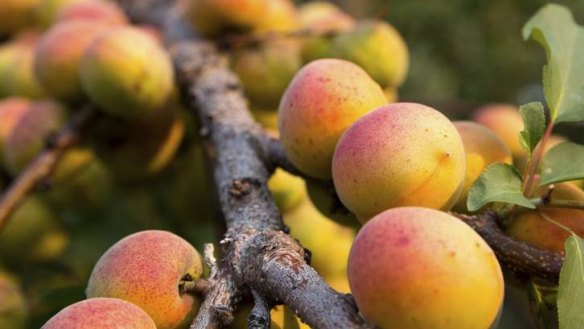Golden harvest worth the risk and effort

As the little yellow finches, blue wrens and willy wagtails bob around the orchard, and the lizards dart from under the wood heaps, I see the deepening yellow of the first apricots.
Apricots that are allowed to fully ripen on the tree are delectable. Apricots picked half ripe and transported hundreds of kilometres to urban centres are so bland you would think they're a different fruit. Apricots make fantastic jams and they do well in a range of desserts and cakes. You can juice them and also bottle them for winter use.
Originating in China, apricots need about 800 hours of winter chill but do best with a hot summer. For Canberra, the challenge lies with their August flowering as they are so susceptible to frosts.
Choosing the right varieties is critical. Trevatt comes from Mildura from the early 1900s; Divinity and Hunter both from South Australia, in the late 1950s and 1966 respectively; Mystery and Watkins from the Riverland area of South Australia. Moorpark from England is another reliable variety for home gardens, and recently I have added Rival from Washington state and Helena.
Most apricot varieties are self pollinators; Rival and Trevatt are good cross pollinators. Trevatt is one of the best mid-season apricots; Moorpark and Hunter are excellent late-season fruit.
Apricots will often set too much fruit, so thin early to prevent the branches breaking and to avoid triggering a biennial cropping regime. January, after harvest, is the best time to prune back long, willowy or too-high branches. Since apricot trees are very susceptible to fungal infection, prune in the midsummer heat, never in winter, to avoid the problem.
Apricot scab, caused by a wet spring, can make the skin of your apricots very unattractive. The best prevention is a pre-leaf fall spray of Bordeaux (Kocide) in late autumn. Bacterial gummosis is another issue with apricot trees, especially when you have long wet periods. A Bordeaux spray at leaf fall and just before budburst is a good preventative.
Growing my own apricots is worth the challenge. Each season I know I am embarking on a high-risk venture in a climate with lots of heavy frosts, but I look forward to those days between Christmas and New Year when the harvest is plentiful and the jam jars and Vacola bottles need to be scoured out and sterilised for another grand cook-up.
This week, I'm:
■ Finish mulching vegetable gardens, rows of berries and small orchard trees before setting off on holidays. Twice a week, water all fruit trees and vegetable gardens. If you have plants in pots, keep up daily watering in the cool of the morning or night.
■ Bend over the stems of onions as they come close to being fully ripe, to prevent top head. Harvest one week later.
■ If you have grown and harvested garlic, you can plant a follow-on crop of snowpeas, bush beans, beetroot or leafy salad greens.
■ Plant out sugarloaf cabbage and bok choy over the next weeks.
■ Keep checking your apples for signs of codling moth burrowing deep into the fruit.
>> Owen Pidgeon runs the Loriendale Organic Orchard near Hall.
Restaurant reviews, news and the hottest openings served to your inbox.
Sign up